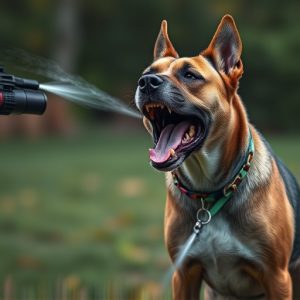Dog Pepper Spray: Legal, Safe Use in Restricted States
Dog pepper spray, though popular for non-lethal defense against attackers, faces stringent regulatio…….
Dog pepper spray, though popular for non-lethal defense against attackers, faces stringent regulations across the US, with significant restrictions in many states due to its potency and potential harm. Before considering it, dog owners must understand local laws regarding Dog Pepper Spray Restricted States, as penalties for illegal use can be severe. It should only be employed responsibly, as a last resort, in unprovoked attacks or emergency situations, with training in simulated scenarios to minimize injury risk. Alternative protective measures like obedience training, fencing, and specialized gear are viable options in states where dog pepper spray is banned.
“Unleashing Protection: Navigating Dog Pepper Spray in a Legal Maze. In today’s diverse dog-owning society, understanding non-lethal defense tools like dog pepper spray is paramount. This comprehensive guide explores ‘Dog Pepper Spray Restricted States’ and delves into its effectiveness, safety, and legal considerations. From understanding the mechanism to training responsible usage, we uncover when it’s justified. Additionally, alternative measures are considered, offering a holistic view of protective options for dog owners.”
- Understanding Dog Pepper Spray: A Non-Lethal Defense Tool
- Legal Considerations: Dog Pepper Spray in Restricted States
- Effective Use Cases: When is Pepper Spray on Dogs Justified?
- Safety and Training: Ensuring Responsible Usage
- Alternative Measures: Exploring Other Protective Options for Dog Owners
Understanding Dog Pepper Spray: A Non-Lethal Defense Tool
Dog pepper spray is a non-lethal defense tool designed to incapacitate an attacker temporarily, allowing dogs and their owners to escape potentially dangerous situations. It’s a popular choice for dog owners seeking protection, especially in areas where self-defense weapons like stun guns or firearms are restricted or prohibited. Dog pepper spray works by targeting the eyes, nose, and respiratory system, causing temporary blindness, coughing, and difficulty breathing. This can give dogs and their handlers enough time to retreat to safety.
It’s crucial to note that dog pepper spray laws vary significantly across the United States. While it’s widely available in many states, there are restrictions on its use and carry in others. Dog pepper spray is typically prohibited in certain public places like schools, airports, and government buildings. Additionally, some states have specific requirements for purchasing, carrying, and storing dog pepper spray to ensure responsible use. Understanding these rules is essential for legal and safe ownership.
Legal Considerations: Dog Pepper Spray in Restricted States
In many jurisdictions, dog pepper spray is subject to strict regulations due to its potent nature and potential impact on both pets and humans. Several states have implemented laws restricting the possession, use, and distribution of dog pepper spray, highlighting a delicate balance between personal safety and animal welfare. These restrictions vary widely across the country, with some states allowing it for specific purposes like law enforcement or personal defense in certain situations, while others outright ban it.
For those considering using dog pepper spray, understanding these legal considerations is paramount. Using prohibited pepper spray can lead to severe legal repercussions, including fines and imprisonment. It’s crucial to check local laws before purchasing or employing any form of pepper spray, especially when living in Dog Pepper Spray Restricted States. Staying informed about these regulations ensures compliance with the law while also ensuring safety for both yourself and your surroundings.
Effective Use Cases: When is Pepper Spray on Dogs Justified?
In certain situations, dog pepper spray can be an effective tool for personal defense against aggressive dogs. Its use is often justified when individuals or their pets are at immediate risk from a dangerous canine. Some restricted states allow the carrying of pepper spray for self-defense purposes, but it’s crucial to understand local laws and regulations before considering its use.
The justification for using dog pepper spray comes into play primarily when facing unprovoked attacks from dogs known or suspected to be vicious. It can also be used as a last resort if an individual is being chased or cornered by a dog, providing temporary relief until help arrives. However, responsible use is paramount; pepper spray should not be employed for non-emergency situations due to its potential impact on both the aggressor and other nearby animals, including pets and wildlife.
Safety and Training: Ensuring Responsible Usage
Dog pepper spray, while offering a non-lethal defense option for pet owners, comes with significant safety considerations. It’s crucial to understand that dog pepper spray is a powerful irritant designed to temporarily disable an aggressor, not cause harm. Responsible usage requires thorough training and understanding of local laws. Not all states allow the use of pepper spray on dogs due to potential risk to animal welfare and public safety; some even have restrictions on who can possess and use it.
Before employing dog pepper spray, ensure you’re familiar with your state’s regulations regarding its use. Responsible owners should also practice simulated scenarios in controlled environments to learn proper application techniques. This training is essential to minimize the risk of injury to both the targeted aggressor and bystanders, as well as potential harm to the owner’s pet.
Alternative Measures: Exploring Other Protective Options for Dog Owners
While dog pepper spray offers a powerful defense against potential threats, it’s crucial to explore alternative protective options available to dog owners. Not all states allow the use of pepper spray, with many having specific restrictions or outright bans, adding complexity for responsible dog owners looking to safeguard their pets.
In such cases, considering other measures becomes essential. Training your dog in basic commands and enrolling them in obedience classes can significantly enhance your control during potentially stressful situations. Additionally, securing your property with robust fences and gates, choosing leashes and collars designed for control, and carrying a loud whistle for deterrence are effective alternatives that don’t rely on pepper spray.
Dog pepper spray can be a powerful tool for self-defense in specific situations, but its usage comes with legal restrictions, especially in restricted states. While it offers a non-lethal solution, responsible use and proper training are paramount to ensure safety for both owners and dogs. Exploring alternative protective measures alongside understanding when and how to employ dog pepper spray can empower owners to make informed decisions, navigating the fine line between self-preservation and legal boundaries.


